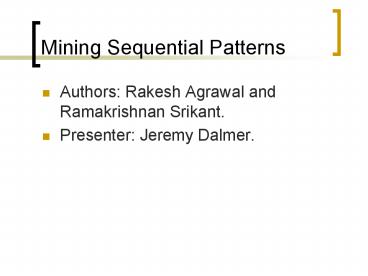Mining Sequential Patterns - PowerPoint PPT Presentation
1 / 29
Title:
Mining Sequential Patterns
Description:
Requires set of attributes deciding each tuple's class. Call this the class ... Joe, 10000, {knife, orange juice, beer} Sarah, 10001, {knife, milk, beer} ... – PowerPoint PPT presentation
Number of Views:73
Avg rating:3.0/5.0
Title: Mining Sequential Patterns
1
Mining Sequential Patterns
- Authors Rakesh Agrawal and Ramakrishnan Srikant.
- Presenter Jeremy Dalmer.
2
Introduction
- What is a sequential pattern?
- Answers to final exam questions.
3
What is a sequential pattern?
- Requires set of attributes deciding each tuples
class. Call this the class set. - Exampleitems-purchasedclass set customer-id
- Tuples are sorted into classes.
4
- Requires set of attributes used for ordering
tuples. Call this the order set. - Exampleitems-purchasedorder set transaction-time
- Tuples within classes are sorted according to an
order defined over order set codomain.
5
- Specifying a value for each attribute in (class
set U order set) must be specifying at most one
tuple. (class set U order set forms primary
key.) - Support and confidence measure classes now, not
tuples.
6
- Exampleitems-purchasedorder set transaction-timecl
ass set customer-idorange juice, beerbeerink, Band-Aids
7
- Classes Joe, Sarah
8
- Ordering within classes according to order set
9
- A large sequence (support 100) is
- (intuitive)
- I, , ,
- , , and
- are also large sequences.
10
- Exampleorder set
year, monthclass set goldfish, lobsterlobstertiger
11
- Classes
12
- Ordering within classes (class!) according to
- order set
13
- Intuition suggests large sequence
- but this is not considered any larger than
- and
- because there is only one class.
14
- One more point about the previous example.
- Having recorded
- monkey as a large sequence, why
- record subsequences?
- and , though
- large sequences, are not informative.
- Maximal sequence.
15
final exam questions
- Root of each algorithm(1) Group into classes
and order.(2) Find all large itemsets.(3) For
each tuple, drop everything except a record of
the large itemsets contained in that tuple.(4)
Find all large sequences (of large itemsets).(5)
Discard large sequences not maximal.
16
- Consider a previous example.
17
- Large itemsets (min-sup 100) knife, beer,
knife, beer, Band-Aids. - Set knife to 1, beer to 2, knife, beer to
3, and Band-Aids to 4. - Transform tuples to((1 2 3) (1 4))((1 2 3) (4))
18
- Large sequences (actually with 100 support)
are((1)), ((2)), ((3)), ((4)),((1) (4)), ((2)
(4)), and ((3) (4)) - But, since ((3) (4)) implies all the others, only
((3) (4)) is a maximal large sequence.
19
- Potentially large vs. Definitely large (candidate
sequences vs. large sequences). - Potentially large no counting, but many.
- Definitely large counting, but few.
- Algorithms similar to Apriori, but with sequences
of large itemsets instead of large sets of items.
20
- AprioriAll Counts every large sequence,
including those not maximal. - AprioriSome Generates every candidate sequence,
but skips counting some large sequences (Forward
Phase). Then, discards candidates not maximal
and counts remaining large sequences (Backward
Phase).
21
- AprioriAll scans the database more, taking more
time. - AprioriSome keeps more potentially large
sequences in memory, degenerating to AprioriAll
when requests for memory fail.
22
- There were two types of algorithms presented to
find sequential patterns, CountSome and CountAll.
What was the main difference between the two
algorithms?
23
- CountAll (AprioriAll) is careful with respect to
minimum support, careless with respect to
maximality.CountSome (AprioriSome) is careful
with respect to maximality, careless with respect
to minimum support.
24
- What was the greatest hardware concern regarding
the algorithms contained in the paper?
25
- Main memory capacity. When there is little main
memory, or many potentially large sequences, the
benefits of AprioriSome vanish.
26
- How did the two best sequence mining algorithms
(AprioriAll and AprioriSome) perform compared
with each other? Take into consideration memory,
speed, and usefulness of the data.
27
- MemoryIn terms of main memory usage, AprioriAll
is better.In terms of secondary storage access,
AprioriSome is better.
28
- SpeedWith sufficient memory, as minimum support
decreases the difference between AprioriAll and
AprioriSome increases. (AprioriSome is
better.)More large sequences not maximal are
generated.
29
- Usefulness of the dataFor the problem of
finding maximal large sequences, the answer is
Precisely the same..However, AprioriAll finds
all large sequences, while AprioriSome discards
some large sequences that arent maximal.
AprioriAll, then, generates more useful
data.The user may want to know the ratio of the
number of people who bought the first k 1 items
in a sequence to the number of people who bought
the first k items.































